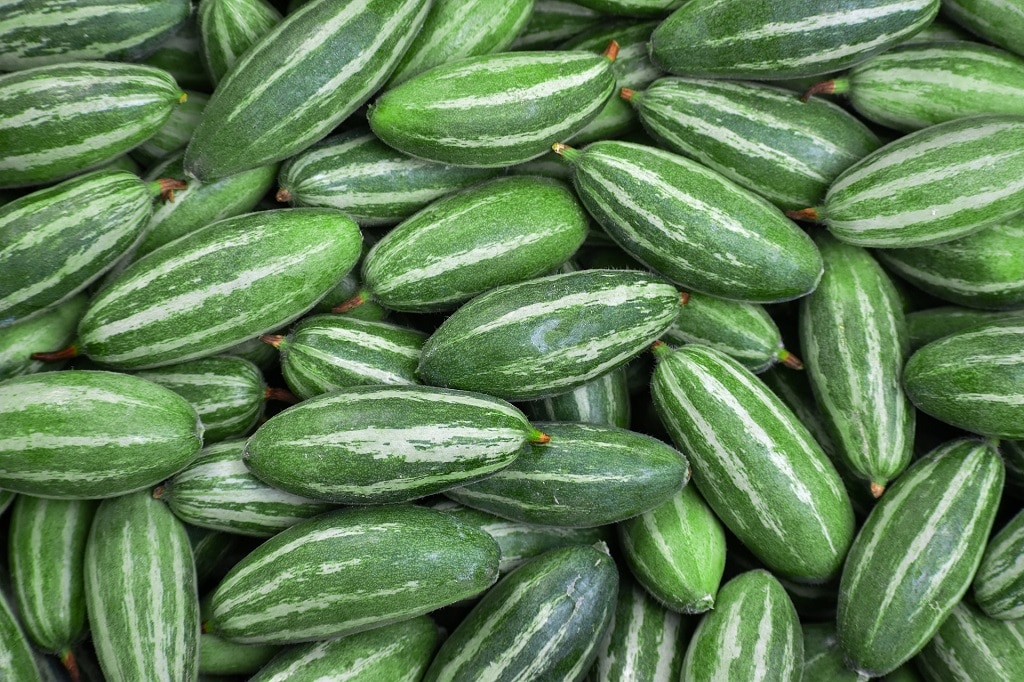
Pointed Gourd (Trichosanthes dioica)
Pointed gourd, also known as Parwal or Parmal, is a popular perennial vegetable crop cultivated primarily in India and other tropical countries. It is a rich source of vitamins, minerals, and dietary fiber. The crop is highly suitable for areas with hot and humid climates and requires proper care for good yield.
Origin and Distribution
- Origin: Believed to have originated in India or Southeast Asia.
- Area and Distribution: Cultivated extensively in India, Bangladesh, and Nepal. Major producing states in India include Bihar, Uttar Pradesh, West Bengal, Odisha, and Assam.
Climate Requirements
- Temperature: Thrives in warm and humid climates with a temperature range of 20°C to 35°C.
- Rainfall: Requires moderate rainfall (100–150 cm annually). Excessive water can lead to root rot.
- Light: Prefers sunny conditions; partial shade can reduce yield.
Soil Requirements
- Type: Well-drained sandy loam to clay loam soil rich in organic matter.
- pH: 6.0–7.5 is ideal.
- Waterlogging: Intolerant to waterlogging; raised beds or ridges are preferred in poorly drained soils.
Improved Varieties
- Rajendra Parwal-1: High-yielding variety, suited for commercial cultivation.
- Swarna Alaukik: Large-sized fruits, tolerant to pests.
- Local Landraces: Widely grown in different regions.
Seed Rate: Propagated through vegetative cuttings (25,000–30,000 cuttings per hectare). Seeds are rarely used due to poor germination.
Propagation
- Pointed gourd is primarily propagated through vegetative cuttings as seeds exhibit poor germination and are rarely used.
- Propagation Material: Vines with 8–10 nodes are used as cuttings. Each cutting should have 2–3 healthy buds.
- Rooting: Treated with rooting hormones like IBA (Indole-3-butyric acid) for better establishment.
Time of Planting: Planting is done in February–March for the summer season and in June–July for the rainy season.
Planting Distance
- Spacing:
- Row-to-row: 2–3 meters.
- Plant-to-plant: 0.5–1.0 meters.
- Pits: Dig pits of 30–45 cm depth and fill them with a mixture of soil, FYM (farmyard manure), and fertilizers before planting.
Manures and Fertilizers
- Basal Dose: 20–25 tonnes of FYM/ha during land preparation.
- Fertilizer Requirement:
- Nitrogen (N): 100–120 kg/ha.
- Phosphorus (P₂O₅): 50–60 kg/ha.
- Potassium (K₂O): 50–60 kg/ha.
- Apply nitrogen in two split doses: half at the time of planting and the rest during vine development.
Irrigation
- Frequency: Regular irrigation is required at 7–10-day intervals.
- Critical Stages: During flowering and fruit development.
- Waterlogging: Avoid water stagnation as it can cause root rot.
Weed Management
- Manual Weeding: Hand weeding at 20–30-day intervals.
- Mulching: Use organic mulch like straw or black polythene to suppress weeds and retain soil moisture.
Pest and Disease Management
- Major Pests:
- Red Pumpkin Beetle: Chews leaves and flowers. Control: Spray Malathion (0.05%) or neem-based pesticides.
- Fruit Fly: Damages fruits by laying eggs inside. Control: Use pheromone traps and apply insecticides like Spinosad.
- Major Diseases:
- Powdery Mildew: White powdery growth on leaves. Control: Spray Sulphur-based fungicides (0.2%).
- Downy Mildew: Yellowing of leaves with fungal growth. Control: Apply Mancozeb or Metalaxyl.
Harvesting
- Maturity: Fruits are ready for harvesting 75–90 days after planting.
- Frequency: Harvest immature fruits every 3–5 days for better yield and quality.
- Yield:
- Vegetative propagation: 8–10 tonnes/ha.
- Proper care and management can increase yield to 12 tonnes/ha.
Physiological Disorders
- Fruit Malformation: Caused by poor pollination or environmental stress. Solution: Maintain proper irrigation and encourage pollinators.
- Fruit Cracking: Due to irregular irrigation or calcium deficiency. Solution: Regular irrigation and calcium-rich fertilizers.

